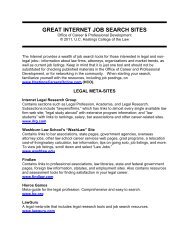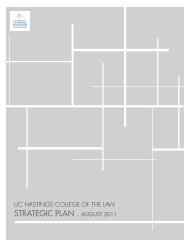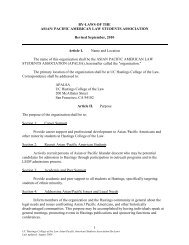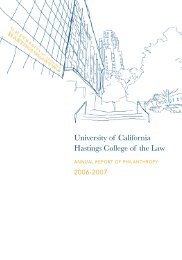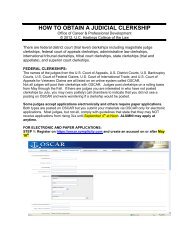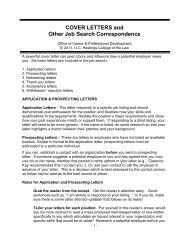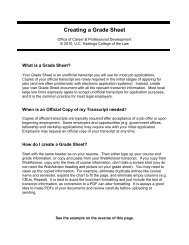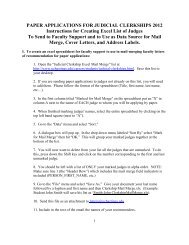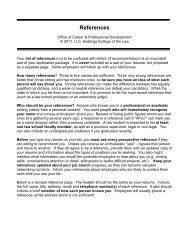Syllabus - Hastings College of the Law
Syllabus - Hastings College of the Law
Syllabus - Hastings College of the Law
You also want an ePaper? Increase the reach of your titles
YUMPU automatically turns print PDFs into web optimized ePapers that Google loves.
Contact Information:<br />
Office: 200 McAllister, Room 331<br />
Office Phone: (415) 581-8809<br />
Cell Phone: (510) 872-3109<br />
Email: loisws@aol.com<br />
CALIFORNIA CIVIL PROCEDURE<br />
<strong>Hastings</strong> <strong>College</strong> <strong>of</strong> <strong>the</strong> <strong>Law</strong> – Spring 2013<br />
Pr<strong>of</strong>. Lois Schwartz<br />
Tuesdays 1:10-3:20 p.m. and Thursdays 1:10-2:10 - Room H<br />
Texts: Levine, Slomanson & Shapell, CALIFORNIA CIVIL PROCEDURE (Thomson/West 4th ed.<br />
2011) and Kane & Levine, CIVIL PROCEDURE IN CALIFORNIA (Thomson/West 2011 edition) are<br />
required. A course reader will also be available.<br />
Class Attendance and Participation: Attendance is mandatory. Students will be responsible<br />
for presenting cases on assigned days.<br />
Basic Information: This is a three-unit course. Students are required to attend a California state<br />
court proceeding or an administrative hearing and to submit a two-page report on your<br />
observations on <strong>the</strong> last day <strong>of</strong> class.<br />
Final Course Grade, Examinations, and Exercises: The writing assignments are 33% <strong>of</strong> your<br />
final course grade and <strong>the</strong> final exam is 67% <strong>of</strong> your final course grade. Writing assignments<br />
total 50 points. Final exam totals 100 points.<br />
Exercises: (1) Legal research worksheet due January 29; (2) Form complaint due February 12;<br />
Motion for Summary Judgment due April 2; (4) Court visit and observation <strong>of</strong> a civil calendar,<br />
hearing, or trial at your convenience – worksheet is due in our last class, April 18.<br />
Sources <strong>of</strong> <strong>Law</strong>:<br />
California Code <strong>of</strong> Civil Procedure (CCP) is <strong>the</strong> main source <strong>of</strong> statutory authority.<br />
California Rules <strong>of</strong> Court (CRC) also apply; <strong>the</strong>y focus on format and procedure.<br />
Local Rules <strong>of</strong> Court. California has 58 counties and each has its own trial court system<br />
(Superior Court). Each Superior Court promulgates its own rules <strong>of</strong> court, subject to preemption<br />
under California Rule <strong>of</strong> Court 3.20. Local rules must be consistent with state rules. They are<br />
available from <strong>the</strong> Superior Court (usually on a website or in pamphlet form) or on o<strong>the</strong>r<br />
websites. The best website is usually http://www.courtinfo.ca.gov.<br />
The U.S. Constitution and <strong>the</strong> California Constitution, article I §§ 1-16 and art. VI §§ 1-4, 6-<br />
13 are also relevant to this course.<br />
Website: http://www.tjsl.edu/slomansonb/CalCivPro.html?q=faculty/slomansonb/CalCivPro.html<br />
1
Learning outcomes:<br />
1. Understanding <strong>of</strong> <strong>the</strong> history and practice <strong>of</strong> California civil procedure.<br />
2. Familiarity with litigation rules and techniques, and alternative dispute resolution.<br />
3. Mastery <strong>of</strong> specialized research skills applicable to California litigation (legal research<br />
assignment).<br />
4. Practice in drafting a complaint (complaint exercise) and formulating a discovery plan<br />
(discovery exercise).<br />
5. Practice in drafting a motion for summary judgment (summary judgment exercise).<br />
6. Actual exposure to trial court practice and procedure (court observation assignment).<br />
7. Development <strong>of</strong> skills in client interviewing, investigation, counseling, negotiation, problem<br />
solving, litigation, and advocacy.<br />
8. Increased understanding <strong>of</strong> <strong>the</strong> ethical standards <strong>of</strong> conduct expected <strong>of</strong> members <strong>of</strong> <strong>the</strong> legal<br />
pr<strong>of</strong>ession, and <strong>the</strong> ability to recognize ethical dilemmas and resolve <strong>the</strong>m appropriately.<br />
9. Awareness <strong>of</strong> how courts interpret and apply procedural rules.<br />
Week One: Thursday 1/10<br />
CALIFORNIA CIVIL PROCEDURE SYLLABUS<br />
Thursday: Chapter One (Introduction), pages 1-36<br />
Relevant statutes: CCP §§ 32.5-36, 77, 85-86, 88, 90-95, 284, 410.10.<br />
Relevant Rule <strong>of</strong> Court: CRC 2.30.<br />
Cases: Schmier, p. 9 (selective publication <strong>of</strong> court <strong>of</strong> appeal decisions); Vidrio, p. 15 (interplay<br />
between California Rules <strong>of</strong> Court, local rules, and statutes).<br />
A supplementary note on <strong>the</strong> unusual application <strong>of</strong> precedent in California:<br />
“Under <strong>the</strong> doctrine <strong>of</strong> stare decisis, all tribunals exercising inferior jurisdiction are required to follow<br />
decisions <strong>of</strong> courts exercising superior jurisdiction. O<strong>the</strong>rwise, <strong>the</strong> doctrine <strong>of</strong> stare decisis makes no<br />
sense. The decisions <strong>of</strong> this court are binding upon and must be followed by all <strong>the</strong> state courts <strong>of</strong><br />
California. Decisions <strong>of</strong> every division <strong>of</strong> <strong>the</strong> District Courts <strong>of</strong> Appeal are binding upon all <strong>the</strong> justice<br />
and municipal courts and upon all <strong>the</strong> superior courts <strong>of</strong> this state, and this is so whe<strong>the</strong>r or not <strong>the</strong><br />
superior court is acting as a trial or appellate court. Courts exercising inferior jurisdiction must accept<br />
<strong>the</strong> law declared by courts <strong>of</strong> superior jurisdiction.”<br />
Auto Equity Sales, Inc. v. Super. Ct. <strong>of</strong> Santa Clara County, 57 Cal. 2d 450, 455 (1962).<br />
Continued . . .<br />
2
Week Two: Tuesday 1/15 & Thursday 1/17<br />
Distribution <strong>of</strong> Assignment One: Legal Research Worksheet. Due 1/29.<br />
Assignment Four: Court visit and observation <strong>of</strong> a civil calendar, civil hearing, or civil trial at<br />
your convenience – worksheet (in reader) due in last class, 4/18.<br />
Tuesday & Thursday: Chapter Two (Jurisdiction, Venue & Conflict <strong>of</strong> <strong>Law</strong>s)<br />
Section A. Pages 37-47<br />
Subject matter jurisdiction: Classification <strong>of</strong> cases as limited<br />
or unlimited<br />
Section B.1 Pages 47-58 Jurisdiction over persons: bases <strong>of</strong> personal jurisdiction.<br />
Section B.2 Pages 58-70 Service <strong>of</strong> process.<br />
Section B.3 Pages 70-78 General and special appearances<br />
Cases: Stern, p. 40 (classification as unlimited v. limited civil case); Snowney v. Harrah’s, p. 49<br />
(specific jurisdiction [in contrast to general jurisdiction] over nonresident defendant); Espindola,<br />
p. 58 (reasonable diligence must precede substituted service <strong>of</strong> process); Dill, p. 62 (must serve<br />
designated individual representative, not just company generally); Air Machine Com SRL v.<br />
Superior Ct., p. 71 (what constitutes a general appearance and <strong>the</strong>refore precludes motion to<br />
dismiss for lack <strong>of</strong> personal jurisdiction).<br />
Relevant statutes: CCP §§ 85-88; CCP §§ 403.010-403.070; CCP §§ 410.10 (CA long-arm<br />
statute) and following. CCP §§ 413.10-417.40 (proper service on individuals and corporations),<br />
CCP §§ 1014 (submission to jurisdiction), 418.10 (motion to quash service).<br />
Continued . . .<br />
3
Week Three: Tuesday 1/22 and Thursday 1/24<br />
Tuesday: Chapter Two, continued<br />
Section C.1 Pages79-87 Venue: Proper county<br />
Section C.2 Pages 87-97 Forum non conveniens<br />
Section D.1 Pages 97-99 Conflict <strong>of</strong> laws: Introduction<br />
Section D.2 Pages 99-109 Conflict <strong>of</strong> laws: Tort actions<br />
Section D.3 Pages109-116 Conflict <strong>of</strong> laws: Contract actions<br />
Cases: Brown, p. 79 (mixed actions; conflict between special and general venue provisions);<br />
Guimei v. GE Co., p. 88 (forum non conveniens); Kearney, p. 99 (retaining CA jurisdiction when<br />
tortious conduct [undisclosed wiretapping] is illegal in this state but not ano<strong>the</strong>r); Brack, p. 109<br />
(choice <strong>of</strong> law provision in contract).<br />
Relevant statutes: CCP §§392-398 (venue); CCP §§ 410.10, 410.30, 410.40, 418.10(a)(2)<br />
(FNC).<br />
Thursday: Chapter Three (Pleadings and Joinder)<br />
Section A.1 Pages 117-126 Special filing and pre-filing requirements.<br />
Section A.2 Pages 126-139 Pleading causes <strong>of</strong> action; elements <strong>of</strong> a complaint.<br />
Cases: City <strong>of</strong> Stockton, p. 120 (filing government claim); Bockrath, p. 129 (precision in<br />
pleading for each element <strong>of</strong> cause <strong>of</strong> action); Dept. <strong>of</strong> Transportation, p. 134 (Judicial Council<br />
form complaint is not demurrer-pro<strong>of</strong>).<br />
Relevant statutes: CCP §§ 905 (government claims), 422.10, 422.30, 425.10, 425-425.12 (form<br />
pleadings), 452 (construction <strong>of</strong> pleadings).<br />
Note especially: CCP § 425.10(a)(1) (“ordinary and concise language”) and CCP § 452 (liberal<br />
construction <strong>of</strong> pleadings).<br />
Relevant Rule <strong>of</strong> Court: Rule 3.1112 (formerly CRC 312) (format).<br />
Note: The court can also impose pre-filing requirements on vexatious litigators; such actions are<br />
distinguishable from administrative requirements that a litigant file a claim with <strong>the</strong> proper<br />
government agency prior to bringing a civil suit in superior court.<br />
Continued . . .<br />
4
Week Four: Tuesday 1/29 & Thursday 1/31<br />
Tuesday: Chapter Three, continued.<br />
Assignment One (Legal Research Worksheet) due today.<br />
Distribution <strong>of</strong> Assignment Two: Draft a Form Complaint. Due 2/12.<br />
Section A.3 Pages 139-153 Demand for judgment or prayer for relief as final<br />
component <strong>of</strong> <strong>the</strong> complaint<br />
Section A.4 Pages 153-154 Economic litigation procedure (limited civil cases)<br />
Note: The complaint consists <strong>of</strong> a heading, statement <strong>of</strong> jurisdiction, causes <strong>of</strong> action, prayer<br />
for relief [also called a demand for judgment]; and signature. It must be served with a<br />
summons pursuant to CCP §§ 412.20 et seq. and <strong>the</strong> party must provide pro<strong>of</strong> <strong>of</strong> service to<br />
<strong>the</strong> court.<br />
Cases: Schwab, p. 141 (P will take nothing by default judgment for personal injury unless<br />
Statement <strong>of</strong> Damages is filed prior to judgment); <strong>College</strong> Hosp., p. 147 (substantial probability<br />
standard for alleging punitive damages against health care provider).<br />
Relevant statutes: CCP § 92-98, 425.10 (demand for judgment), § 425.11 (separate statement<br />
<strong>of</strong> damages for personal injury/wrongful death claims), § 425.115 (punitive damages); § 425.13<br />
(causes <strong>of</strong> action against health care providers).<br />
Thursday: Chapter Three, continued<br />
Section B.1 Pages 155-160 Responses: General demurrer<br />
Section B.2 Pages 160-163 Responses: Special demurrer<br />
Section B.3 Pages 163-164 Responses: Motion to strike<br />
Section B.4 Pages 164-165 Reponses: Judgment on <strong>the</strong> pleadings<br />
Section B.5 Pages 165-167 Motion Practice<br />
Cases: Sheehan v. SF 49ers, p. 156 (demurrer).<br />
Relevant statutes: § 472a (general demurrers); § 430.10(f) (special demurrers); CCP §§ 435-<br />
437 (motions to strike); CCP § 438 (judgment on <strong>the</strong> pleadings).<br />
Relevant Rule <strong>of</strong> Court: Rule 3.1320 (formerly CRC 325).<br />
Continued . . .<br />
5
Week Five: Tuesday 2/5 & Thursday 2/7<br />
Tuesday: Chapter Three, continued<br />
Section C.1 Pages 167-168 The answer: general and specific denials<br />
Section C.2 Pages 168-201 The answer: affirmative defenses, including statute <strong>of</strong><br />
limitations<br />
Section D Pages 201-210 Cross-complaint<br />
Cases: Advantec Group, p. 169 (affirmative defense based on licensing); Norgart , p. 174<br />
(affirmative defense based on start date for SOL); Jolly v. Eli Lilly, p. 179 (SOL period starts<br />
when P suspects or should suspect that she has been wronged); Lantzy v. Centex Homes, p. 189<br />
(effect <strong>of</strong> latent defect on SOL); Align Technology, Inc. v. Tran, p. 201 (cross-complaint)<br />
Relevant statutes: CCP § 1014 (D appears by filing an answer); CCP § 431.30 (answer);<br />
statutory limitations periods vary, depending on cause <strong>of</strong> action.<br />
Thursday: Chapter Three, continued<br />
Section E.1 Pages 210-212 Amendments: General practice<br />
Section E.2 Pages 212-227 Relation back<br />
Section F.1 Pages 228-235 Truth in Pleading: Frivolous pleadings<br />
Section F.2 Pages 236-251 Truth in Pleading: Anti-SLAPP motions<br />
Cases: Davaloo, p. 213 (relation back and revival period for claims); Fuller v. Tucker, p. 222;<br />
(Doe defendants); Li v. Majestic Industry Hills, LLC, p. 230 (frivolous pleadings); Flatley v.<br />
Mauro, p. 241 (motion to strike under anti-SLAPP statute).<br />
Relevant statutes: CCP §§ 472 (right to amend complaint without leave <strong>of</strong> court); CCP § 473<br />
(amendment by leave <strong>of</strong> court); CCP § 474 (Doe defendants); CCP §§ 127-128.5 (frivolous<br />
pleadings and sanctions); §§ 425.16-425.18 (Anti-SLAPP actions).<br />
Continued . . .<br />
6
Week Six: Tuesday 2/12.<br />
Thursday 2/14 – no class (this Thursday is treated as a Monday)<br />
Assignment Two (Form Complaint) due today 2/12.<br />
Tuesday: Chapter Three, continued<br />
Section G.1 Pages 269-270 Special Joinder Devices: Consolidation<br />
Section G.2 Pages 271-276 Special Joinder Devices: Interpleader<br />
Section G.3 Pages 276-284 Special Joinder Devices: Intervention<br />
Section G.4 No reading assigned Special Joinder Devices: Class actions and representative<br />
suits.<br />
Cases: Morgan Hill v. Brown, p. 271 (interpleader); San Francisco v. State, p. 276<br />
(intervention).<br />
Relevant statutes: CCP §§ 427.10 (joinder <strong>of</strong> causes <strong>of</strong> action by plaintiff); 428.10-428.70<br />
(joinder <strong>of</strong> parties); CCP § 1048 (consolidation); CCP §§ 378-379 (permissive joinder <strong>of</strong><br />
parties); CCP § 386 (interpleader); CCP § 387 (intervention); CCP § 389 (compulsory joinder);<br />
CCP § 382 (class action).<br />
Week Seven: Tuesday 2/19 & Thursday 2/21<br />
Tuesday & Thursday: Chapter Four (Discovery)<br />
Section A Pages 306-311 Discovery philosophy<br />
Section B.1 Pages 311-315 Scope <strong>of</strong> discovery: Informal discovery<br />
Section B.2 Pages 315-320 Scope <strong>of</strong> discovery: Relevance and admissibility<br />
Section B.3 Pages 320-350 Scope <strong>of</strong> discovery: Protection from discovery.<br />
Cases: Greyhound, p. 307 (test for objectives <strong>of</strong> Discovery Act); Pullin, p. 312 (distinguishing<br />
investigation from formal discovery); Stewart, p. 316 (defining what might reasonably lead to<br />
admissible evidence); Pioneer Electronics, p. 321 (privileged information); Hernandez, p. 329<br />
(must ID privileged documents even if <strong>the</strong>re is a right to refuse to produce <strong>the</strong>m later); RICO v.<br />
Mitsubishi, p. 335 (attorney-client privilege); County <strong>of</strong> Los Angeles, p. 341 (dispute over expert<br />
witness).<br />
Relevant statutes: CCP § 2016.010 et seq. (California Discovery Act), CCP § 2017.010 et seq.<br />
(scope); §§ 2018.010 et seq. (attorney work product), §§ 2019.010 et seq. (methods & sequence<br />
<strong>of</strong> discovery); §§ 2020.010 et seq. (nonparty discovery).<br />
Relevant Rules <strong>of</strong> Court: Rule 3.1000 (formerly CRC 331) (format <strong>of</strong> supplemental and fur<strong>the</strong>r<br />
discovery), Rule 3.1020 (formerly CRC 335) (format <strong>of</strong> discovery motions), Rule 3.1030<br />
(formerly CRC 341) (sanctions for failure to provide discovery).<br />
7
Week Eight: Tuesday 2/26 & Thursday 2/28<br />
Tuesday and Thursday: Chapter Four, continued<br />
Section C.1 Pages 350-358 Discovery devices: Interrogatories<br />
Section C.2 Pages 358-366 Discovery devices: Depositions<br />
Section C.3 Pages 366-374 Discovery devices: Physical and mental examinations<br />
Section C.4 Pages 374-381 Discovery devices: Inspection <strong>of</strong> documents and things<br />
Section C.5 Pages 381-389 Discovery devices: Requests for admission<br />
Section C.6 Pages 389-394 Discovery devices: Continuing discovery<br />
Section C.7 Pages 394-402 Discovery devices: Electronic discovery<br />
Section D Pages 403-409 Experts<br />
The case book provides concise explanations and good cases illustrating <strong>the</strong> types <strong>of</strong> discovery.<br />
Read <strong>the</strong> explanatory material, but <strong>the</strong> cases are not required reading.<br />
Cases: Sinaiko Healthcare Consulting, Inc., p. 352; Maldonado v. Superior Ct., p. 360, Vinson<br />
v. Superior Ct., p. 367; Stadish v. Superior Ct., p. 374; New Albertsons, Inc. v. Superior Ct., p.<br />
382; Biles v. Exxon, p. 389; Toshiba v. Superior Ct., p. 397; Bonds v. Roy, p. 404.<br />
Relevant statutes: CCP §§ 2030.010 et seq. (interrogatories); CCP §§ 2025.010 et seq.<br />
(depositions); CCP §§ 2032.010 et seq. (physical & mental examinations); CCP §§ 2031.010 et<br />
seq. (inspection & production <strong>of</strong> documents, things, land, and o<strong>the</strong>r property); CCP §§ 2033.010<br />
et seq. (requests for admission); CCP § 2017.730 (use <strong>of</strong> technology in conducting discovery);<br />
CCP §§ 2034.010 et seq. (exchange <strong>of</strong> expert witness information).<br />
Continued . . .<br />
8
Week Nine: Tuesday 3/5 & Thursday 3/7<br />
Tuesday: Chapter Four, continued<br />
Section E.1 Pages 409-415 Systematic oversight: Meet and confer requirement<br />
Section E.2 Pages 415-426 Systematic oversight: Discovery sanctions<br />
Section E.3 Pages 426-435 Systematic oversight: Protective orders<br />
Section E.4 Pages 435-442 Systematic oversight: Discovery completion<br />
Section E.5 Pages 442-446 Systematic oversight: Punitive damages<br />
Cases: Obregon, p. 410 (mandatory attempts at informal resolution <strong>of</strong> conflict); Doppes v.<br />
Bentley Motors, p. 418 (discovery sanctions); Planned Parenthood, p. 427 (protective orders);<br />
Fairmont Ins. Co., p. 435 (completion <strong>of</strong> discovery); Jabro, p. 442 (discovery <strong>of</strong> financial<br />
information for purposes <strong>of</strong> punitive damages).<br />
Relevant statutes: California Government Code § 68607 provides authority for judges to<br />
manage cases under <strong>the</strong> Trial Court Delay Reduction Act; CCP § 2023 (discovery sanctions);<br />
CCP §§ 485.050 & 486.070 (protective orders).<br />
Relevant Rules <strong>of</strong> Court: Rule 3.713 (formerly CRC 208) (delay reduction goals); Rule 3.714<br />
(formerly CRC 209) (differentiation <strong>of</strong> cases); Rule 3.715 (formerly CRC 210 (case evaluation<br />
factors), and Rules 720–3.730 (formerly CRC 212) (case management rules); see also Rule<br />
3.1380 (formerly CRC 222) (mandatory settlement conferences) and Rule 3.1385 (formerly CRC<br />
225) (notification <strong>of</strong> settlement). See also Rule 2.30 (formerly CRC 227) (sanctions for rules<br />
violations in civil cases).<br />
Thursday: Chapter Five (Disposition without Trial)<br />
Section C.1 Pages 503-505 Case Management: Delay reduction (Fast Track)<br />
Section C.2 Pages 505-511 Case Management: Sanctions<br />
Section D.1 Pages 511-519 Dismissal: Voluntary dismissal<br />
Section D.2 Pages 519-529 Dismissal: Involuntary dismissal<br />
Section E Pages 530-540 Default and default judgment<br />
Cases: Garcia v. McCutcheon, p. 506 (penalties for failure to comply with Fast Track); Franklin<br />
Capital Corp., p. 511 (voluntary dismissal); Landry, p. 520 (involuntary dismissal); Tamburina,<br />
p. 524 (exception to five-year dismissal provision); Fasuyi, p. 530.<br />
Relevant statutes: The Trial Court Delay Reduction Act <strong>of</strong> 1986 is <strong>the</strong> basis for local fast-track<br />
rules. It is codified at California Government Code § 68603 et seq. CCP § 581 (dismissal); CCP<br />
§§ 583.130-583.520 (dismissal for delay in prosecution); CCP §§ 580, 585 & 585.5, 586 (default).<br />
Relevant Rules <strong>of</strong> Court: Rule 3.1340 (formerly CRC 372) and Rule 3.1342 (formerly CRC<br />
373) (motions to dismiss for failure to prosecute).<br />
9
Week Ten: Tuesday 3/12 & Thursday 3/14<br />
No Class – Spring Break<br />
Week Eleven: Tuesday 3/19 & Thursday 3/21<br />
Tuesday: Chapter Five, continued<br />
Distribution <strong>of</strong> Assignment Three: Motion for Summary Judgment. Due 4/2.<br />
Section A Pages 448-492 Arbitration<br />
Section B Pages 493-503 Mediation<br />
Section F Pages 540-541 Settlement & Offer <strong>of</strong> settlement<br />
Section G.1 Pages 575-578 Summary judgment: State-federal comparison<br />
Section G.2 Pages 579-588 Summary judgment: California essentials<br />
Cases: Kojababian, p. 584; Moncharch, p. 451 (contractual arbitration); Engalla, p. 463<br />
(compelling arbitration); Armendariz, p. 473 (public policy objections to arbitration); Porreco v.<br />
Red Top, p. 487 (judicial arbitration); Foxgate, p. 495 (confidentiality in mediation); Robinson v.<br />
Woods, p. 579.<br />
Relevant statutes: CCP §§ 1281, 1281.2, 1281.4 (enforcement <strong>of</strong> arbitration agreements); CCP<br />
§ 437c (MSJ/MSA)<br />
Relevant Rule <strong>of</strong> Court: Rules 10.780 et seq. (formerly CRC 1580) (administration <strong>of</strong> ADR<br />
programs), Rules 3.810 et seq. (formerly CRC 1600 et seq.) (judicial arbitration); CCP § 998<br />
(costs following rejection <strong>of</strong> <strong>of</strong>fer to settle). Rule 3.1350 (formerly CRC 342) (MSJ/MSA).<br />
Thursday: Chapter Five, continued<br />
Section H.1 Pages 588-595 Relief from Orders and Judgments: Reconsideration<br />
Section H.2 Pages 595-605 Relief from Orders and Judgments: Relief from Judgment<br />
Cases: Le Francois v. Goel, p. 589 (motion for reconsideration); Zamora, p. 596 (motion for<br />
relief from judgment based on mistake, inadvertence, surprise, or excusable neglect).<br />
Related Statutes: CCP § 1008 (reconsideration); CCP §§ 473(b) (relief from judgment).<br />
Continued . . .<br />
10
Week Twelve: Tuesday 3/26 & Thursday 3/28<br />
Tuesday: Chapter Six (Trial)<br />
Section A.1 Pages 607-626 Obtaining Trial by Jury: Right to trial by jury<br />
Section A.2 Pages 626-643 Obtaining Trial by Jury: Jury Venire<br />
Section A.3 Pages 643-655 Obtaining Trial by Jury: Jury Panel<br />
Relevant statutes: CCP § 592 (jury trial), CCP § 598 (precedence <strong>of</strong> issues), CCP § 607-630<br />
(trial by jury); CCP § 631 (waiver <strong>of</strong> jury trial/demand for jury trial); Cal. Const. art. I, § 16.<br />
Cases: Crouchman, p. 608 (P has no right to appeal from small claims judgment; D may obtain<br />
trial de novo in Superior Court); Grafton, p. 616 (waiver <strong>of</strong> right to trial by jury); People v.<br />
Burgener, p. 627 (composition <strong>of</strong> jury); Williams, p. 634 (cross section <strong>of</strong> community); People v.<br />
Garcia, p. 646 (cognizable groups).<br />
Thursday: Chapter Six, continued<br />
Section B.1 Pages 655-666 Advising <strong>the</strong> Jury: Instructions<br />
Section B.2 Pages 666-669 Advising <strong>the</strong> Jury: Commenting on <strong>the</strong> evidence<br />
Section C Not assigned Verdicts<br />
The materials at pages 669-681 relating to jury verdicts and impeachment <strong>of</strong> jury verdicts is very<br />
interesting, but is not required reading.<br />
Case: Mitchell v. Gonzales, p. 657 (jury instructions must reflect current law).<br />
Relevant statutes: CCP § 607a (proposed jury instructions: CCP § 608 (charge to <strong>the</strong> jury);<br />
CCP § 613 (jury deliberation); CCP § 618 (verdict; polling <strong>the</strong> jury).<br />
Relevant Rules <strong>of</strong> Court: Rule 3.1540 (examination <strong>of</strong> jurors in civil case); Rule 2.1055<br />
(proposed jury instructions); Rule 2.1050 (Judicial Council jury instructions); Rule 2.1008<br />
(excuses from jury service).<br />
Continued . . .<br />
11
Week Thirteen: Tuesday 4/2 & Thursday 4/4<br />
Tuesday: Chapter Six, continued; Chapter 7 (Provisional Remedies)<br />
Assignment Three (Motion for Summary Judgment) due today 4/2.<br />
Section D.1 Pages 681-687 Judicial Control <strong>of</strong> <strong>the</strong> Jury: Nonsuit<br />
Section D.2 Pages 687-688 Judicial Control <strong>of</strong> <strong>the</strong> Jury: Directed verdict<br />
Section D.3 Pages 689-694 Judicial Control <strong>of</strong> <strong>the</strong> Jury: JNOV<br />
Section D.4 Pages 694-705 Judicial Control <strong>of</strong> <strong>the</strong> Jury: Motion for new trial<br />
Cases: Panico, p. 682 (nonsuit); Dailey, p. 687 (directed verdict); Garretson, p. 689 (JNOV);<br />
Fountain Valley Chateau Blanc HOA, p. 695 (motion for new trial).<br />
Relevant statutes: CCP § 581c (motion for nonsuit); CCP § 630 (motion for directed verdict);<br />
CCP § 629 (motion for JNOV); CCP § 657 (motion for new trial; see also California<br />
Constitution article VI, § 13); CCP § 128(a)(8) (motion to reverse or vacate judgment); CCP §<br />
663 (motion to set aside judgment).<br />
Section A.1 No reading assigned Provisional remedies: Attachment for security<br />
Section A.2 No reading assigned Provisional remedies: TROs and Preliminary injunctions<br />
Section B.1 No reading assigned Enforcement <strong>of</strong> judgment and orders: Execution<br />
Section B.2 No reading assigned Enforcement <strong>of</strong> judgment and orders: Contempt <strong>of</strong> court<br />
Section C No reading assigned Costs and attorney’s fees<br />
Thursday: Chapter 8 (Appellate Review)<br />
Section A Pages 775-777 Right to Appeal – Writ Review<br />
Section B.1 Pages 777-789 Appealability: Appealable judgments and orders<br />
Section B.2 Pages 796-803 Appealability: Nonappealable orders<br />
Cases: Morehart, p. 778 (identifying a final judgment); Roden v. Amerisourcebergen Corp., p.<br />
786 (appealability <strong>of</strong> post-trial discovery order). Science Applications Internat’l Corp, p. 798<br />
(extraordinary writs).<br />
Relevant statutes: CCP §§ 901 et seq.; see especially CCP § 904.1(a) (one final judgment rule);<br />
CCP § 906 (prejudicial error).<br />
Continued . . .<br />
12
Week Fourteen: Tuesday 4/9 & Thursday 4/11<br />
Tuesday & Thursday: Chapter 9 (Prior Adjudication)<br />
Section A No reading assigned Stare Decisis<br />
Section B Page 854 Res Judicata<br />
Section B.1 Pages 854-864 Claim Preclusion (res judicata)<br />
Section B.2 Pages 867-876 Issue Preclusion (collateral estoppel)<br />
Cases: Boeken v. Philip Morris, U.S.A., p. 856 (primary right doctrine); Hernandez, p. 867<br />
(issue preclusion).<br />
Related Reading: Prior adjudication & primary right doctrine: stare decisis and res judicata<br />
(claim and issue preclusion) (pp. 917-939).<br />
Week Fifteen: Tuesday 4/16 & Thursday 4/18<br />
Practical applications.<br />
Assignment Four ((worksheet on court visit and observation <strong>of</strong> a civil calendar, civil hearing, or<br />
civil trial) due 4/18.<br />
FINAL EXAM – TENTATIVE DATE<br />
Tuesday, April 23<br />
Have a Great Semester Break!<br />
13



